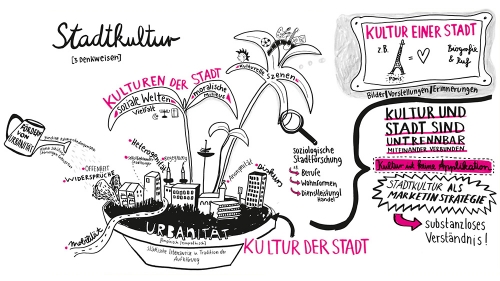
Three ways of thinking about urban culture
An attempt to visually bring together three different ways of thinking about urban culture – based on the essay “Stadtkultur” (“Urban Culture”) by Rolf Lindner.

To what extent can the internet or individual digital services be of help to you when researching the imaginaries of a city?
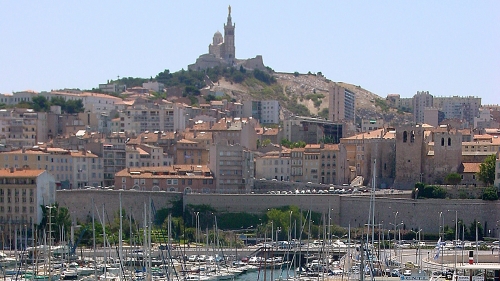

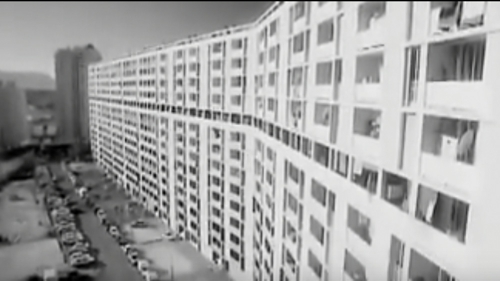
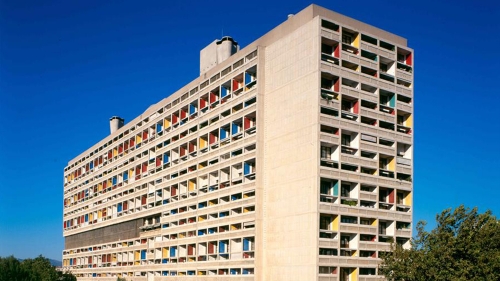
A collection of images about the imaginary of urbanity
What characterises imaginary of urbanity? A collection of representations of urbanity – expanded by the website’s users.
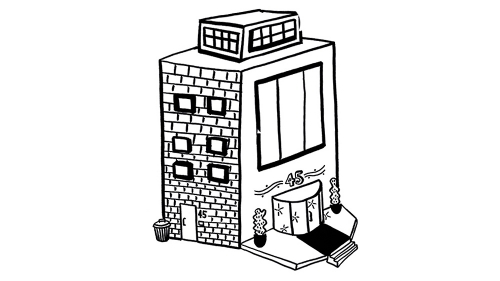
Notice: Undefined variable: skin in /homepages/21/d269329667/htdocs/clickandbuilds/Stadtkulturen/wp-content/plugins/media-element-html5-video-and-audio-player/mediaelement-js-wp.php on line 405
Notice: Undefined variable: src_attribute in /homepages/21/d269329667/htdocs/clickandbuilds/Stadtkulturen/wp-content/plugins/media-element-html5-video-and-audio-player/mediaelement-js-wp.php on line 410
Notice: Undefined variable: type_attribute in /homepages/21/d269329667/htdocs/clickandbuilds/Stadtkulturen/wp-content/plugins/media-element-html5-video-and-audio-player/mediaelement-js-wp.php on line 410
Notice: Undefined variable: width_attribute in /homepages/21/d269329667/htdocs/clickandbuilds/Stadtkulturen/wp-content/plugins/media-element-html5-video-and-audio-player/mediaelement-js-wp.php on line 410
Notice: Undefined variable: height_attribute in /homepages/21/d269329667/htdocs/clickandbuilds/Stadtkulturen/wp-content/plugins/media-element-html5-video-and-audio-player/mediaelement-js-wp.php on line 410
Notice: Undefined variable: poster_attribute in /homepages/21/d269329667/htdocs/clickandbuilds/Stadtkulturen/wp-content/plugins/media-element-html5-video-and-audio-player/mediaelement-js-wp.php on line 410
Notice: Undefined variable: autoplay_attribute in /homepages/21/d269329667/htdocs/clickandbuilds/Stadtkulturen/wp-content/plugins/media-element-html5-video-and-audio-player/mediaelement-js-wp.php on line 410
Notice: Undefined variable: mp4_source in /homepages/21/d269329667/htdocs/clickandbuilds/Stadtkulturen/wp-content/plugins/media-element-html5-video-and-audio-player/mediaelement-js-wp.php on line 411
Notice: Undefined variable: mp3_source in /homepages/21/d269329667/htdocs/clickandbuilds/Stadtkulturen/wp-content/plugins/media-element-html5-video-and-audio-player/mediaelement-js-wp.php on line 412
Notice: Undefined variable: webm_source in /homepages/21/d269329667/htdocs/clickandbuilds/Stadtkulturen/wp-content/plugins/media-element-html5-video-and-audio-player/mediaelement-js-wp.php on line 413
Notice: Undefined variable: flv_source in /homepages/21/d269329667/htdocs/clickandbuilds/Stadtkulturen/wp-content/plugins/media-element-html5-video-and-audio-player/mediaelement-js-wp.php on line 414
Notice: Undefined variable: wmv_source in /homepages/21/d269329667/htdocs/clickandbuilds/Stadtkulturen/wp-content/plugins/media-element-html5-video-and-audio-player/mediaelement-js-wp.php on line 415
Notice: Undefined variable: ogg_source in /homepages/21/d269329667/htdocs/clickandbuilds/Stadtkulturen/wp-content/plugins/media-element-html5-video-and-audio-player/mediaelement-js-wp.php on line 416
Notice: Undefined variable: captions_source in /homepages/21/d269329667/htdocs/clickandbuilds/Stadtkulturen/wp-content/plugins/media-element-html5-video-and-audio-player/mediaelement-js-wp.php on line 417
Notice: Undefined variable: loop_option in /homepages/21/d269329667/htdocs/clickandbuilds/Stadtkulturen/wp-content/plugins/media-element-html5-video-and-audio-player/mediaelement-js-wp.php on line 423
Notice: Undefined variable: mediahtml in /homepages/21/d269329667/htdocs/clickandbuilds/Stadtkulturen/wp-content/plugins/media-element-html5-video-and-audio-player/mediaelement-js-wp.php on line 425
2:30
Urbanism, social space and the “poor doors”
From the phenomenon of “poor doors” to research on planning practices. An excerpt from a conversation with Yuca Meubrink about her research on housing programs in New York City and London.

Which aspects are emphasised by the concept of urbanity as assemblage?

Link a platform or website that you use to discuss or participate in issues that are urban-related and give your opinion. Describe when and how you use it.
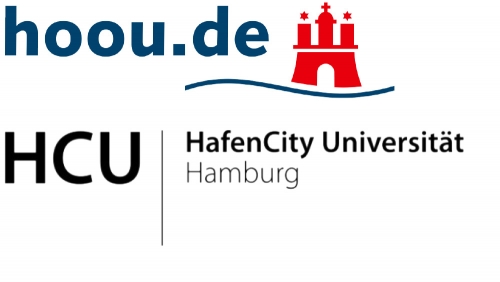
Imprint
Metropolitan Culture HafenCity University Hamburg Überseeallee 16 20457 Hamburg www.hcu-hamburg.de Contact: pgf-kulturdermetropole@hcu-hamburg.de Tel. +49 (0)40 42827 – 5205 Legal representative: President of the HCU Prof. Dr. Jörg Müller-Lietzkow Responsible regulatory authority: The Public Agency for Science and Research Hamburger Straße 37 22083 Hamburg VAT registration number:

Notice: Undefined variable: skin in /homepages/21/d269329667/htdocs/clickandbuilds/Stadtkulturen/wp-content/plugins/media-element-html5-video-and-audio-player/mediaelement-js-wp.php on line 405
Notice: Undefined variable: src_attribute in /homepages/21/d269329667/htdocs/clickandbuilds/Stadtkulturen/wp-content/plugins/media-element-html5-video-and-audio-player/mediaelement-js-wp.php on line 410
Notice: Undefined variable: type_attribute in /homepages/21/d269329667/htdocs/clickandbuilds/Stadtkulturen/wp-content/plugins/media-element-html5-video-and-audio-player/mediaelement-js-wp.php on line 410
Notice: Undefined variable: width_attribute in /homepages/21/d269329667/htdocs/clickandbuilds/Stadtkulturen/wp-content/plugins/media-element-html5-video-and-audio-player/mediaelement-js-wp.php on line 410
Notice: Undefined variable: height_attribute in /homepages/21/d269329667/htdocs/clickandbuilds/Stadtkulturen/wp-content/plugins/media-element-html5-video-and-audio-player/mediaelement-js-wp.php on line 410
Notice: Undefined variable: poster_attribute in /homepages/21/d269329667/htdocs/clickandbuilds/Stadtkulturen/wp-content/plugins/media-element-html5-video-and-audio-player/mediaelement-js-wp.php on line 410
Notice: Undefined variable: autoplay_attribute in /homepages/21/d269329667/htdocs/clickandbuilds/Stadtkulturen/wp-content/plugins/media-element-html5-video-and-audio-player/mediaelement-js-wp.php on line 410
Notice: Undefined variable: mp4_source in /homepages/21/d269329667/htdocs/clickandbuilds/Stadtkulturen/wp-content/plugins/media-element-html5-video-and-audio-player/mediaelement-js-wp.php on line 411
Notice: Undefined variable: mp3_source in /homepages/21/d269329667/htdocs/clickandbuilds/Stadtkulturen/wp-content/plugins/media-element-html5-video-and-audio-player/mediaelement-js-wp.php on line 412
Notice: Undefined variable: webm_source in /homepages/21/d269329667/htdocs/clickandbuilds/Stadtkulturen/wp-content/plugins/media-element-html5-video-and-audio-player/mediaelement-js-wp.php on line 413
Notice: Undefined variable: flv_source in /homepages/21/d269329667/htdocs/clickandbuilds/Stadtkulturen/wp-content/plugins/media-element-html5-video-and-audio-player/mediaelement-js-wp.php on line 414
Notice: Undefined variable: wmv_source in /homepages/21/d269329667/htdocs/clickandbuilds/Stadtkulturen/wp-content/plugins/media-element-html5-video-and-audio-player/mediaelement-js-wp.php on line 415
Notice: Undefined variable: ogg_source in /homepages/21/d269329667/htdocs/clickandbuilds/Stadtkulturen/wp-content/plugins/media-element-html5-video-and-audio-player/mediaelement-js-wp.php on line 416
Notice: Undefined variable: captions_source in /homepages/21/d269329667/htdocs/clickandbuilds/Stadtkulturen/wp-content/plugins/media-element-html5-video-and-audio-player/mediaelement-js-wp.php on line 417
Notice: Undefined variable: loop_option in /homepages/21/d269329667/htdocs/clickandbuilds/Stadtkulturen/wp-content/plugins/media-element-html5-video-and-audio-player/mediaelement-js-wp.php on line 423
Notice: Undefined variable: mediahtml in /homepages/21/d269329667/htdocs/clickandbuilds/Stadtkulturen/wp-content/plugins/media-element-html5-video-and-audio-player/mediaelement-js-wp.php on line 425
0:57
Urbanism, social space and critical urban research
How does critical urban research investigate urbanism? In conversation with Yuca Meubrink about her research on housing programs in New York City and London.

When I research urban phenomena with the concept of urbanity as an assemblage, I emphasise social relationships as …
Pinterest® – thinking in terms of the imaginary as a concept
Click through the webpage. To what extent does Pinterest® produce urbanity in the sense of the imaginary?

When I research urban phenomena with the concept of urbanity as an assemblage, I emphasise social relationships as …

Notice: Undefined variable: skin in /homepages/21/d269329667/htdocs/clickandbuilds/Stadtkulturen/wp-content/plugins/media-element-html5-video-and-audio-player/mediaelement-js-wp.php on line 405
Notice: Undefined variable: src_attribute in /homepages/21/d269329667/htdocs/clickandbuilds/Stadtkulturen/wp-content/plugins/media-element-html5-video-and-audio-player/mediaelement-js-wp.php on line 410
Notice: Undefined variable: type_attribute in /homepages/21/d269329667/htdocs/clickandbuilds/Stadtkulturen/wp-content/plugins/media-element-html5-video-and-audio-player/mediaelement-js-wp.php on line 410
Notice: Undefined variable: width_attribute in /homepages/21/d269329667/htdocs/clickandbuilds/Stadtkulturen/wp-content/plugins/media-element-html5-video-and-audio-player/mediaelement-js-wp.php on line 410
Notice: Undefined variable: height_attribute in /homepages/21/d269329667/htdocs/clickandbuilds/Stadtkulturen/wp-content/plugins/media-element-html5-video-and-audio-player/mediaelement-js-wp.php on line 410
Notice: Undefined variable: poster_attribute in /homepages/21/d269329667/htdocs/clickandbuilds/Stadtkulturen/wp-content/plugins/media-element-html5-video-and-audio-player/mediaelement-js-wp.php on line 410
Notice: Undefined variable: autoplay_attribute in /homepages/21/d269329667/htdocs/clickandbuilds/Stadtkulturen/wp-content/plugins/media-element-html5-video-and-audio-player/mediaelement-js-wp.php on line 410
Notice: Undefined variable: mp4_source in /homepages/21/d269329667/htdocs/clickandbuilds/Stadtkulturen/wp-content/plugins/media-element-html5-video-and-audio-player/mediaelement-js-wp.php on line 411
Notice: Undefined variable: mp3_source in /homepages/21/d269329667/htdocs/clickandbuilds/Stadtkulturen/wp-content/plugins/media-element-html5-video-and-audio-player/mediaelement-js-wp.php on line 412
Notice: Undefined variable: webm_source in /homepages/21/d269329667/htdocs/clickandbuilds/Stadtkulturen/wp-content/plugins/media-element-html5-video-and-audio-player/mediaelement-js-wp.php on line 413
Notice: Undefined variable: flv_source in /homepages/21/d269329667/htdocs/clickandbuilds/Stadtkulturen/wp-content/plugins/media-element-html5-video-and-audio-player/mediaelement-js-wp.php on line 414
Notice: Undefined variable: wmv_source in /homepages/21/d269329667/htdocs/clickandbuilds/Stadtkulturen/wp-content/plugins/media-element-html5-video-and-audio-player/mediaelement-js-wp.php on line 415
Notice: Undefined variable: ogg_source in /homepages/21/d269329667/htdocs/clickandbuilds/Stadtkulturen/wp-content/plugins/media-element-html5-video-and-audio-player/mediaelement-js-wp.php on line 416
Notice: Undefined variable: captions_source in /homepages/21/d269329667/htdocs/clickandbuilds/Stadtkulturen/wp-content/plugins/media-element-html5-video-and-audio-player/mediaelement-js-wp.php on line 417
Notice: Undefined variable: loop_option in /homepages/21/d269329667/htdocs/clickandbuilds/Stadtkulturen/wp-content/plugins/media-element-html5-video-and-audio-player/mediaelement-js-wp.php on line 423
Notice: Undefined variable: mediahtml in /homepages/21/d269329667/htdocs/clickandbuilds/Stadtkulturen/wp-content/plugins/media-element-html5-video-and-audio-player/mediaelement-js-wp.php on line 425
0:33
Urbanism and social space
What is social space and how can you research this concept? An excerpt from a conversation with Yuca Meubrink about her research on housing programs in New York City and London.
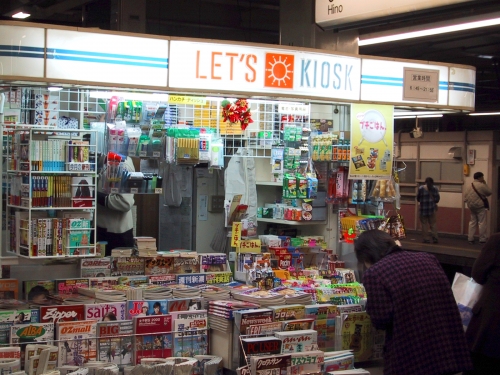
How can you work with cultural studies concepts?
In cultural studies, concepts serve to look at phenomena of everyday (urban) life from a certain perspective. This is an attempt to understand the particular dynamics and quality of these phenomena. These concepts do not comprehensively explain the urban world but provide systematic ways of thinking to interpret the real world in an argumentative way. Often not only one concept, but the
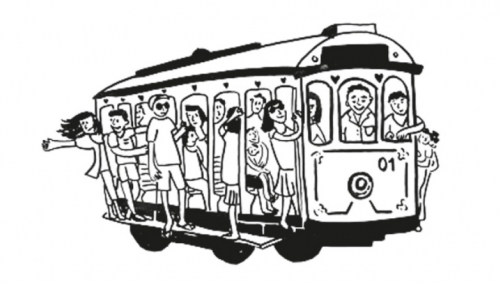
Notice: Undefined variable: skin in /homepages/21/d269329667/htdocs/clickandbuilds/Stadtkulturen/wp-content/plugins/media-element-html5-video-and-audio-player/mediaelement-js-wp.php on line 405
Notice: Undefined variable: src_attribute in /homepages/21/d269329667/htdocs/clickandbuilds/Stadtkulturen/wp-content/plugins/media-element-html5-video-and-audio-player/mediaelement-js-wp.php on line 410
Notice: Undefined variable: type_attribute in /homepages/21/d269329667/htdocs/clickandbuilds/Stadtkulturen/wp-content/plugins/media-element-html5-video-and-audio-player/mediaelement-js-wp.php on line 410
Notice: Undefined variable: width_attribute in /homepages/21/d269329667/htdocs/clickandbuilds/Stadtkulturen/wp-content/plugins/media-element-html5-video-and-audio-player/mediaelement-js-wp.php on line 410
Notice: Undefined variable: height_attribute in /homepages/21/d269329667/htdocs/clickandbuilds/Stadtkulturen/wp-content/plugins/media-element-html5-video-and-audio-player/mediaelement-js-wp.php on line 410
Notice: Undefined variable: poster_attribute in /homepages/21/d269329667/htdocs/clickandbuilds/Stadtkulturen/wp-content/plugins/media-element-html5-video-and-audio-player/mediaelement-js-wp.php on line 410
Notice: Undefined variable: autoplay_attribute in /homepages/21/d269329667/htdocs/clickandbuilds/Stadtkulturen/wp-content/plugins/media-element-html5-video-and-audio-player/mediaelement-js-wp.php on line 410
Notice: Undefined variable: mp4_source in /homepages/21/d269329667/htdocs/clickandbuilds/Stadtkulturen/wp-content/plugins/media-element-html5-video-and-audio-player/mediaelement-js-wp.php on line 411
Notice: Undefined variable: mp3_source in /homepages/21/d269329667/htdocs/clickandbuilds/Stadtkulturen/wp-content/plugins/media-element-html5-video-and-audio-player/mediaelement-js-wp.php on line 412
Notice: Undefined variable: webm_source in /homepages/21/d269329667/htdocs/clickandbuilds/Stadtkulturen/wp-content/plugins/media-element-html5-video-and-audio-player/mediaelement-js-wp.php on line 413
Notice: Undefined variable: flv_source in /homepages/21/d269329667/htdocs/clickandbuilds/Stadtkulturen/wp-content/plugins/media-element-html5-video-and-audio-player/mediaelement-js-wp.php on line 414
Notice: Undefined variable: wmv_source in /homepages/21/d269329667/htdocs/clickandbuilds/Stadtkulturen/wp-content/plugins/media-element-html5-video-and-audio-player/mediaelement-js-wp.php on line 415
Notice: Undefined variable: ogg_source in /homepages/21/d269329667/htdocs/clickandbuilds/Stadtkulturen/wp-content/plugins/media-element-html5-video-and-audio-player/mediaelement-js-wp.php on line 416
Notice: Undefined variable: captions_source in /homepages/21/d269329667/htdocs/clickandbuilds/Stadtkulturen/wp-content/plugins/media-element-html5-video-and-audio-player/mediaelement-js-wp.php on line 417
Notice: Undefined variable: loop_option in /homepages/21/d269329667/htdocs/clickandbuilds/Stadtkulturen/wp-content/plugins/media-element-html5-video-and-audio-player/mediaelement-js-wp.php on line 423
Notice: Undefined variable: mediahtml in /homepages/21/d269329667/htdocs/clickandbuilds/Stadtkulturen/wp-content/plugins/media-element-html5-video-and-audio-player/mediaelement-js-wp.php on line 425
1:43
Urbanism, assemblage and conflicts
What potential does the assemblage perspective hold for thinking about urban conflicts? In conversation with Laura Kemmer about assemblage and her research on the Bonde tram in Rio de Janeiro.
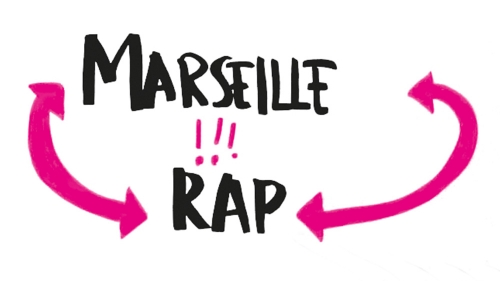
Notice: Undefined variable: skin in /homepages/21/d269329667/htdocs/clickandbuilds/Stadtkulturen/wp-content/plugins/media-element-html5-video-and-audio-player/mediaelement-js-wp.php on line 405
Notice: Undefined variable: src_attribute in /homepages/21/d269329667/htdocs/clickandbuilds/Stadtkulturen/wp-content/plugins/media-element-html5-video-and-audio-player/mediaelement-js-wp.php on line 410
Notice: Undefined variable: type_attribute in /homepages/21/d269329667/htdocs/clickandbuilds/Stadtkulturen/wp-content/plugins/media-element-html5-video-and-audio-player/mediaelement-js-wp.php on line 410
Notice: Undefined variable: width_attribute in /homepages/21/d269329667/htdocs/clickandbuilds/Stadtkulturen/wp-content/plugins/media-element-html5-video-and-audio-player/mediaelement-js-wp.php on line 410
Notice: Undefined variable: height_attribute in /homepages/21/d269329667/htdocs/clickandbuilds/Stadtkulturen/wp-content/plugins/media-element-html5-video-and-audio-player/mediaelement-js-wp.php on line 410
Notice: Undefined variable: poster_attribute in /homepages/21/d269329667/htdocs/clickandbuilds/Stadtkulturen/wp-content/plugins/media-element-html5-video-and-audio-player/mediaelement-js-wp.php on line 410
Notice: Undefined variable: autoplay_attribute in /homepages/21/d269329667/htdocs/clickandbuilds/Stadtkulturen/wp-content/plugins/media-element-html5-video-and-audio-player/mediaelement-js-wp.php on line 410
Notice: Undefined variable: mp4_source in /homepages/21/d269329667/htdocs/clickandbuilds/Stadtkulturen/wp-content/plugins/media-element-html5-video-and-audio-player/mediaelement-js-wp.php on line 411
Notice: Undefined variable: mp3_source in /homepages/21/d269329667/htdocs/clickandbuilds/Stadtkulturen/wp-content/plugins/media-element-html5-video-and-audio-player/mediaelement-js-wp.php on line 412
Notice: Undefined variable: webm_source in /homepages/21/d269329667/htdocs/clickandbuilds/Stadtkulturen/wp-content/plugins/media-element-html5-video-and-audio-player/mediaelement-js-wp.php on line 413
Notice: Undefined variable: flv_source in /homepages/21/d269329667/htdocs/clickandbuilds/Stadtkulturen/wp-content/plugins/media-element-html5-video-and-audio-player/mediaelement-js-wp.php on line 414
Notice: Undefined variable: wmv_source in /homepages/21/d269329667/htdocs/clickandbuilds/Stadtkulturen/wp-content/plugins/media-element-html5-video-and-audio-player/mediaelement-js-wp.php on line 415
Notice: Undefined variable: ogg_source in /homepages/21/d269329667/htdocs/clickandbuilds/Stadtkulturen/wp-content/plugins/media-element-html5-video-and-audio-player/mediaelement-js-wp.php on line 416
Notice: Undefined variable: captions_source in /homepages/21/d269329667/htdocs/clickandbuilds/Stadtkulturen/wp-content/plugins/media-element-html5-video-and-audio-player/mediaelement-js-wp.php on line 417
Notice: Undefined variable: loop_option in /homepages/21/d269329667/htdocs/clickandbuilds/Stadtkulturen/wp-content/plugins/media-element-html5-video-and-audio-player/mediaelement-js-wp.php on line 423
Notice: Undefined variable: mediahtml in /homepages/21/d269329667/htdocs/clickandbuilds/Stadtkulturen/wp-content/plugins/media-element-html5-video-and-audio-player/mediaelement-js-wp.php on line 425
1:06
Urbanity, the imaginary and rap in Marseille
Exploring urban imaginary – how can this be achieved? An excerpt from a conversation with Daniel Tödt about the imaginary of the city and his research on rap music in Marseille.

Laura Kemmer
Laura Kammer holds a degree in Political Science from the University of Hamburg and completed her Master’s degree in International Relations in Berlin in 2013. She is currently working on her doctoral thesis (PhD) in the field of urban studies at the TU Berlin on “Bonding: The emergence of new collectives around an absent tram in Rio de Janeiro”.
Yelp® – thinking in terms of social space as a concept
Click through the page. How does Yelp® produce urbanity in the sense of the concept of social space?
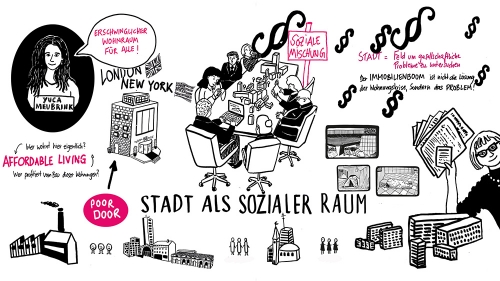
Urbanism as a field with which to research societal issues
An attempt to visually summarise some aspects of the concept of urbanism as a social space. This graphic recording was created after discussions with Yuca Meubrink about her research on housing programs in New York City and London.
Twitter® and thinking about the assemblage concept
Click through the webpage. To what extent does “Twitter” produce urbanity in the sense of urban assemblage?

Notice: Undefined variable: skin in /homepages/21/d269329667/htdocs/clickandbuilds/Stadtkulturen/wp-content/plugins/media-element-html5-video-and-audio-player/mediaelement-js-wp.php on line 405
Notice: Undefined variable: src_attribute in /homepages/21/d269329667/htdocs/clickandbuilds/Stadtkulturen/wp-content/plugins/media-element-html5-video-and-audio-player/mediaelement-js-wp.php on line 410
Notice: Undefined variable: type_attribute in /homepages/21/d269329667/htdocs/clickandbuilds/Stadtkulturen/wp-content/plugins/media-element-html5-video-and-audio-player/mediaelement-js-wp.php on line 410
Notice: Undefined variable: width_attribute in /homepages/21/d269329667/htdocs/clickandbuilds/Stadtkulturen/wp-content/plugins/media-element-html5-video-and-audio-player/mediaelement-js-wp.php on line 410
Notice: Undefined variable: height_attribute in /homepages/21/d269329667/htdocs/clickandbuilds/Stadtkulturen/wp-content/plugins/media-element-html5-video-and-audio-player/mediaelement-js-wp.php on line 410
Notice: Undefined variable: poster_attribute in /homepages/21/d269329667/htdocs/clickandbuilds/Stadtkulturen/wp-content/plugins/media-element-html5-video-and-audio-player/mediaelement-js-wp.php on line 410
Notice: Undefined variable: autoplay_attribute in /homepages/21/d269329667/htdocs/clickandbuilds/Stadtkulturen/wp-content/plugins/media-element-html5-video-and-audio-player/mediaelement-js-wp.php on line 410
Notice: Undefined variable: mp4_source in /homepages/21/d269329667/htdocs/clickandbuilds/Stadtkulturen/wp-content/plugins/media-element-html5-video-and-audio-player/mediaelement-js-wp.php on line 411
Notice: Undefined variable: mp3_source in /homepages/21/d269329667/htdocs/clickandbuilds/Stadtkulturen/wp-content/plugins/media-element-html5-video-and-audio-player/mediaelement-js-wp.php on line 412
Notice: Undefined variable: webm_source in /homepages/21/d269329667/htdocs/clickandbuilds/Stadtkulturen/wp-content/plugins/media-element-html5-video-and-audio-player/mediaelement-js-wp.php on line 413
Notice: Undefined variable: flv_source in /homepages/21/d269329667/htdocs/clickandbuilds/Stadtkulturen/wp-content/plugins/media-element-html5-video-and-audio-player/mediaelement-js-wp.php on line 414
Notice: Undefined variable: wmv_source in /homepages/21/d269329667/htdocs/clickandbuilds/Stadtkulturen/wp-content/plugins/media-element-html5-video-and-audio-player/mediaelement-js-wp.php on line 415
Notice: Undefined variable: ogg_source in /homepages/21/d269329667/htdocs/clickandbuilds/Stadtkulturen/wp-content/plugins/media-element-html5-video-and-audio-player/mediaelement-js-wp.php on line 416
Notice: Undefined variable: captions_source in /homepages/21/d269329667/htdocs/clickandbuilds/Stadtkulturen/wp-content/plugins/media-element-html5-video-and-audio-player/mediaelement-js-wp.php on line 417
Notice: Undefined variable: loop_option in /homepages/21/d269329667/htdocs/clickandbuilds/Stadtkulturen/wp-content/plugins/media-element-html5-video-and-audio-player/mediaelement-js-wp.php on line 423
Notice: Undefined variable: mediahtml in /homepages/21/d269329667/htdocs/clickandbuilds/Stadtkulturen/wp-content/plugins/media-element-html5-video-and-audio-player/mediaelement-js-wp.php on line 425
1:53
Urbanism, the imaginary and working with concepts
To what extent does the concept of the imaginary help us understand urbanity? An excerpt from a conversation with Daniel Tödt about the imaginary of the city and his research on rap music in Marseille.

Notice: Undefined variable: skin in /homepages/21/d269329667/htdocs/clickandbuilds/Stadtkulturen/wp-content/plugins/media-element-html5-video-and-audio-player/mediaelement-js-wp.php on line 405
Notice: Undefined variable: src_attribute in /homepages/21/d269329667/htdocs/clickandbuilds/Stadtkulturen/wp-content/plugins/media-element-html5-video-and-audio-player/mediaelement-js-wp.php on line 410
Notice: Undefined variable: type_attribute in /homepages/21/d269329667/htdocs/clickandbuilds/Stadtkulturen/wp-content/plugins/media-element-html5-video-and-audio-player/mediaelement-js-wp.php on line 410
Notice: Undefined variable: width_attribute in /homepages/21/d269329667/htdocs/clickandbuilds/Stadtkulturen/wp-content/plugins/media-element-html5-video-and-audio-player/mediaelement-js-wp.php on line 410
Notice: Undefined variable: height_attribute in /homepages/21/d269329667/htdocs/clickandbuilds/Stadtkulturen/wp-content/plugins/media-element-html5-video-and-audio-player/mediaelement-js-wp.php on line 410
Notice: Undefined variable: poster_attribute in /homepages/21/d269329667/htdocs/clickandbuilds/Stadtkulturen/wp-content/plugins/media-element-html5-video-and-audio-player/mediaelement-js-wp.php on line 410
Notice: Undefined variable: autoplay_attribute in /homepages/21/d269329667/htdocs/clickandbuilds/Stadtkulturen/wp-content/plugins/media-element-html5-video-and-audio-player/mediaelement-js-wp.php on line 410
Notice: Undefined variable: mp4_source in /homepages/21/d269329667/htdocs/clickandbuilds/Stadtkulturen/wp-content/plugins/media-element-html5-video-and-audio-player/mediaelement-js-wp.php on line 411
Notice: Undefined variable: mp3_source in /homepages/21/d269329667/htdocs/clickandbuilds/Stadtkulturen/wp-content/plugins/media-element-html5-video-and-audio-player/mediaelement-js-wp.php on line 412
Notice: Undefined variable: webm_source in /homepages/21/d269329667/htdocs/clickandbuilds/Stadtkulturen/wp-content/plugins/media-element-html5-video-and-audio-player/mediaelement-js-wp.php on line 413
Notice: Undefined variable: flv_source in /homepages/21/d269329667/htdocs/clickandbuilds/Stadtkulturen/wp-content/plugins/media-element-html5-video-and-audio-player/mediaelement-js-wp.php on line 414
Notice: Undefined variable: wmv_source in /homepages/21/d269329667/htdocs/clickandbuilds/Stadtkulturen/wp-content/plugins/media-element-html5-video-and-audio-player/mediaelement-js-wp.php on line 415
Notice: Undefined variable: ogg_source in /homepages/21/d269329667/htdocs/clickandbuilds/Stadtkulturen/wp-content/plugins/media-element-html5-video-and-audio-player/mediaelement-js-wp.php on line 416
Notice: Undefined variable: captions_source in /homepages/21/d269329667/htdocs/clickandbuilds/Stadtkulturen/wp-content/plugins/media-element-html5-video-and-audio-player/mediaelement-js-wp.php on line 417
Notice: Undefined variable: loop_option in /homepages/21/d269329667/htdocs/clickandbuilds/Stadtkulturen/wp-content/plugins/media-element-html5-video-and-audio-player/mediaelement-js-wp.php on line 423
Notice: Undefined variable: mediahtml in /homepages/21/d269329667/htdocs/clickandbuilds/Stadtkulturen/wp-content/plugins/media-element-html5-video-and-audio-player/mediaelement-js-wp.php on line 425
1:16
Urbanity, assemblage and smart cities
Can digital practices be analysed using the assemblage approach? In conversation with Laura Kemmer about assemblage and her research on the Bonde tram in Rio de Janeiro.
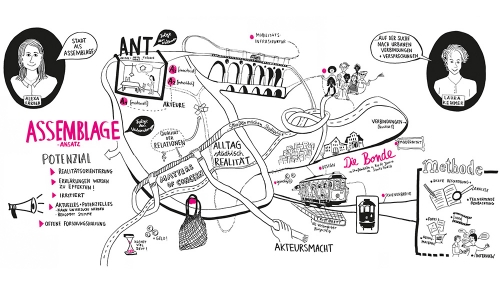
Urbanity as urban assemblage – in search of connections and promises
An attempt to visually summarise some aspects of urban assemblage research. This graphic recording was created during a lecture by Laura Kemmer and Alexa Färber on research with the assemblage approach in the summer of 2016.
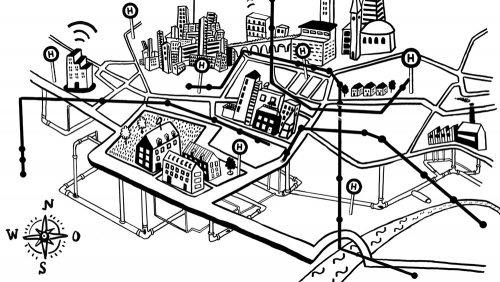
Notice: Undefined variable: skin in /homepages/21/d269329667/htdocs/clickandbuilds/Stadtkulturen/wp-content/plugins/media-element-html5-video-and-audio-player/mediaelement-js-wp.php on line 405
Notice: Undefined variable: src_attribute in /homepages/21/d269329667/htdocs/clickandbuilds/Stadtkulturen/wp-content/plugins/media-element-html5-video-and-audio-player/mediaelement-js-wp.php on line 410
Notice: Undefined variable: type_attribute in /homepages/21/d269329667/htdocs/clickandbuilds/Stadtkulturen/wp-content/plugins/media-element-html5-video-and-audio-player/mediaelement-js-wp.php on line 410
Notice: Undefined variable: poster_attribute in /homepages/21/d269329667/htdocs/clickandbuilds/Stadtkulturen/wp-content/plugins/media-element-html5-video-and-audio-player/mediaelement-js-wp.php on line 410
Notice: Undefined variable: autoplay_attribute in /homepages/21/d269329667/htdocs/clickandbuilds/Stadtkulturen/wp-content/plugins/media-element-html5-video-and-audio-player/mediaelement-js-wp.php on line 410
Notice: Undefined variable: mp3_source in /homepages/21/d269329667/htdocs/clickandbuilds/Stadtkulturen/wp-content/plugins/media-element-html5-video-and-audio-player/mediaelement-js-wp.php on line 412
Notice: Undefined variable: webm_source in /homepages/21/d269329667/htdocs/clickandbuilds/Stadtkulturen/wp-content/plugins/media-element-html5-video-and-audio-player/mediaelement-js-wp.php on line 413
Notice: Undefined variable: flv_source in /homepages/21/d269329667/htdocs/clickandbuilds/Stadtkulturen/wp-content/plugins/media-element-html5-video-and-audio-player/mediaelement-js-wp.php on line 414
Notice: Undefined variable: wmv_source in /homepages/21/d269329667/htdocs/clickandbuilds/Stadtkulturen/wp-content/plugins/media-element-html5-video-and-audio-player/mediaelement-js-wp.php on line 415
Notice: Undefined variable: ogg_source in /homepages/21/d269329667/htdocs/clickandbuilds/Stadtkulturen/wp-content/plugins/media-element-html5-video-and-audio-player/mediaelement-js-wp.php on line 416
Notice: Undefined variable: captions_source in /homepages/21/d269329667/htdocs/clickandbuilds/Stadtkulturen/wp-content/plugins/media-element-html5-video-and-audio-player/mediaelement-js-wp.php on line 417
Notice: Undefined variable: loop_option in /homepages/21/d269329667/htdocs/clickandbuilds/Stadtkulturen/wp-content/plugins/media-element-html5-video-and-audio-player/mediaelement-js-wp.php on line 423
Notice: Undefined variable: mediahtml in /homepages/21/d269329667/htdocs/clickandbuilds/Stadtkulturen/wp-content/plugins/media-element-html5-video-and-audio-player/mediaelement-js-wp.php on line 425
3:27
Urban Assemblage
How research on a tram in Rio de Janeiro contributes to the understanding of urbanity.
Craigslist® – thinking in terms of social space as a concept
Click through the webpage. To what extent does Craigslist® produce urbanity in the sense of the concept of social space?

Bibliography: Urban imaginary
“Although urban communities of a different nature may occur within the matrix of one society, often one pattern is so dominant that it becomes the sole source of urban imagery within a cultural tradition.” (Hannerz 1980: 307) AMIN, ASH/ THRIFT, NIGEL (2002): Cities. Reimagining the Urban. Oxford. BERKING, HELMUTH/ LÖW, MARTINA (2008): Die Eigenlogik der Städte. Neue

Which aspects are emphasised by the concept of urbanity as social space?

Let’s kiosk!
This webpage is intended as a contribution to cultural urban studies and focuses on the connection between theoretical concepts of urbanity and everyday digital practices. The prime concern is on cultural studies to reflect on the uses of digital services as a contribution to the production of everyday-urbanity. Just like a kiosk that offers daily necessities “in passing” for the rea
Facebook® – thinking in terms of social space as a concept
Click through the page. How does Facebook® produce urbanity in the sense of the concept of social space?

Notice: Undefined variable: skin in /homepages/21/d269329667/htdocs/clickandbuilds/Stadtkulturen/wp-content/plugins/media-element-html5-video-and-audio-player/mediaelement-js-wp.php on line 405
Notice: Undefined variable: src_attribute in /homepages/21/d269329667/htdocs/clickandbuilds/Stadtkulturen/wp-content/plugins/media-element-html5-video-and-audio-player/mediaelement-js-wp.php on line 410
Notice: Undefined variable: type_attribute in /homepages/21/d269329667/htdocs/clickandbuilds/Stadtkulturen/wp-content/plugins/media-element-html5-video-and-audio-player/mediaelement-js-wp.php on line 410
Notice: Undefined variable: width_attribute in /homepages/21/d269329667/htdocs/clickandbuilds/Stadtkulturen/wp-content/plugins/media-element-html5-video-and-audio-player/mediaelement-js-wp.php on line 410
Notice: Undefined variable: height_attribute in /homepages/21/d269329667/htdocs/clickandbuilds/Stadtkulturen/wp-content/plugins/media-element-html5-video-and-audio-player/mediaelement-js-wp.php on line 410
Notice: Undefined variable: poster_attribute in /homepages/21/d269329667/htdocs/clickandbuilds/Stadtkulturen/wp-content/plugins/media-element-html5-video-and-audio-player/mediaelement-js-wp.php on line 410
Notice: Undefined variable: autoplay_attribute in /homepages/21/d269329667/htdocs/clickandbuilds/Stadtkulturen/wp-content/plugins/media-element-html5-video-and-audio-player/mediaelement-js-wp.php on line 410
Notice: Undefined variable: mp4_source in /homepages/21/d269329667/htdocs/clickandbuilds/Stadtkulturen/wp-content/plugins/media-element-html5-video-and-audio-player/mediaelement-js-wp.php on line 411
Notice: Undefined variable: mp3_source in /homepages/21/d269329667/htdocs/clickandbuilds/Stadtkulturen/wp-content/plugins/media-element-html5-video-and-audio-player/mediaelement-js-wp.php on line 412
Notice: Undefined variable: webm_source in /homepages/21/d269329667/htdocs/clickandbuilds/Stadtkulturen/wp-content/plugins/media-element-html5-video-and-audio-player/mediaelement-js-wp.php on line 413
Notice: Undefined variable: flv_source in /homepages/21/d269329667/htdocs/clickandbuilds/Stadtkulturen/wp-content/plugins/media-element-html5-video-and-audio-player/mediaelement-js-wp.php on line 414
Notice: Undefined variable: wmv_source in /homepages/21/d269329667/htdocs/clickandbuilds/Stadtkulturen/wp-content/plugins/media-element-html5-video-and-audio-player/mediaelement-js-wp.php on line 415
Notice: Undefined variable: ogg_source in /homepages/21/d269329667/htdocs/clickandbuilds/Stadtkulturen/wp-content/plugins/media-element-html5-video-and-audio-player/mediaelement-js-wp.php on line 416
Notice: Undefined variable: captions_source in /homepages/21/d269329667/htdocs/clickandbuilds/Stadtkulturen/wp-content/plugins/media-element-html5-video-and-audio-player/mediaelement-js-wp.php on line 417
Notice: Undefined variable: loop_option in /homepages/21/d269329667/htdocs/clickandbuilds/Stadtkulturen/wp-content/plugins/media-element-html5-video-and-audio-player/mediaelement-js-wp.php on line 423
Notice: Undefined variable: mediahtml in /homepages/21/d269329667/htdocs/clickandbuilds/Stadtkulturen/wp-content/plugins/media-element-html5-video-and-audio-player/mediaelement-js-wp.php on line 425
2:39
Urbanity, the imaginary and the internet
How has the internet changed rap music in Marseilles? And how has the internet changed how we perceive cities? An excerpt from a conversation with Daniel Tödt about the imaginary of urbanism and his research on rap music in Marseille.

Notice: Undefined variable: skin in /homepages/21/d269329667/htdocs/clickandbuilds/Stadtkulturen/wp-content/plugins/media-element-html5-video-and-audio-player/mediaelement-js-wp.php on line 405
Notice: Undefined variable: src_attribute in /homepages/21/d269329667/htdocs/clickandbuilds/Stadtkulturen/wp-content/plugins/media-element-html5-video-and-audio-player/mediaelement-js-wp.php on line 410
Notice: Undefined variable: type_attribute in /homepages/21/d269329667/htdocs/clickandbuilds/Stadtkulturen/wp-content/plugins/media-element-html5-video-and-audio-player/mediaelement-js-wp.php on line 410
Notice: Undefined variable: width_attribute in /homepages/21/d269329667/htdocs/clickandbuilds/Stadtkulturen/wp-content/plugins/media-element-html5-video-and-audio-player/mediaelement-js-wp.php on line 410
Notice: Undefined variable: height_attribute in /homepages/21/d269329667/htdocs/clickandbuilds/Stadtkulturen/wp-content/plugins/media-element-html5-video-and-audio-player/mediaelement-js-wp.php on line 410
Notice: Undefined variable: poster_attribute in /homepages/21/d269329667/htdocs/clickandbuilds/Stadtkulturen/wp-content/plugins/media-element-html5-video-and-audio-player/mediaelement-js-wp.php on line 410
Notice: Undefined variable: autoplay_attribute in /homepages/21/d269329667/htdocs/clickandbuilds/Stadtkulturen/wp-content/plugins/media-element-html5-video-and-audio-player/mediaelement-js-wp.php on line 410
Notice: Undefined variable: mp4_source in /homepages/21/d269329667/htdocs/clickandbuilds/Stadtkulturen/wp-content/plugins/media-element-html5-video-and-audio-player/mediaelement-js-wp.php on line 411
Notice: Undefined variable: mp3_source in /homepages/21/d269329667/htdocs/clickandbuilds/Stadtkulturen/wp-content/plugins/media-element-html5-video-and-audio-player/mediaelement-js-wp.php on line 412
Notice: Undefined variable: webm_source in /homepages/21/d269329667/htdocs/clickandbuilds/Stadtkulturen/wp-content/plugins/media-element-html5-video-and-audio-player/mediaelement-js-wp.php on line 413
Notice: Undefined variable: flv_source in /homepages/21/d269329667/htdocs/clickandbuilds/Stadtkulturen/wp-content/plugins/media-element-html5-video-and-audio-player/mediaelement-js-wp.php on line 414
Notice: Undefined variable: wmv_source in /homepages/21/d269329667/htdocs/clickandbuilds/Stadtkulturen/wp-content/plugins/media-element-html5-video-and-audio-player/mediaelement-js-wp.php on line 415
Notice: Undefined variable: ogg_source in /homepages/21/d269329667/htdocs/clickandbuilds/Stadtkulturen/wp-content/plugins/media-element-html5-video-and-audio-player/mediaelement-js-wp.php on line 416
Notice: Undefined variable: captions_source in /homepages/21/d269329667/htdocs/clickandbuilds/Stadtkulturen/wp-content/plugins/media-element-html5-video-and-audio-player/mediaelement-js-wp.php on line 417
Notice: Undefined variable: loop_option in /homepages/21/d269329667/htdocs/clickandbuilds/Stadtkulturen/wp-content/plugins/media-element-html5-video-and-audio-player/mediaelement-js-wp.php on line 423
Notice: Undefined variable: mediahtml in /homepages/21/d269329667/htdocs/clickandbuilds/Stadtkulturen/wp-content/plugins/media-element-html5-video-and-audio-player/mediaelement-js-wp.php on line 425
1:58
Urbanity, the imaginary and IAM
How did the hip-hop group IAM shape imaginary Marseilles? An excerpt from a conversation with Daniel Tödt about the imaginary of the city and his research on rap music in Marseille.

Kiosk
“A kiosk is a point of sale of food and drinks for short-term needs, which are then consumed outside the kiosk” – states the trade licensing office, but kiosks are much more than this. They offer opportunities to participate in urban culture in very different ways. People browse through magazines, watch life on the street or socialise. Kiosks are meeting places, places for

“metcouncilonhousing.org” – thinking in terms of social space as a concept
Click through the webpage. To what extent does “metcouncilonhousing.org” produce urbanity in the sense of the concept of social space?

Consider the impact Twitter or the character hashtag (#) have on the localisation of urban affairs. Is there a topic or debate to which you yourself have contributed? To what extent were you involved, what connection did you have to the event?

Digital practices
When invited to an event like a demonstration via Facebook®, the direct impact of digital practices on urban space is clear: People know where they can gather and may also do this. But even the way photos and pictures are dealt with on the internet has an impact on non-digital urban space. For example, online platforms of photo communities or image search engines such as Pinterest® can
“City Data Forum” – thinking in terms of social space as a concept
Click through the webpage. To what extent does the “City Data Forum” produce urbanity in the sense of the concept of social space?

Upload rules and terms of use
When uploading images, elementary copyright issues are affected. Copyright protected material fundamentally requires the permission of the copyright owner or should in the best case be free of such third-party rights. Before uploading material, please find out about the respective legal situation. Comprehensive copyright information can be found here: www.irights.info. Please be aware th

Make a record of an uninterrupted 3-hour period in your daily routine and highlight all the digital practices involved. Answer the following questions: To what extent do these practices produce urbanity as a social space? Which digital practices did you use to participate in group processes? What classifications and distinctions did you make digitally and to what extent do they relate to urbanity as a social space?
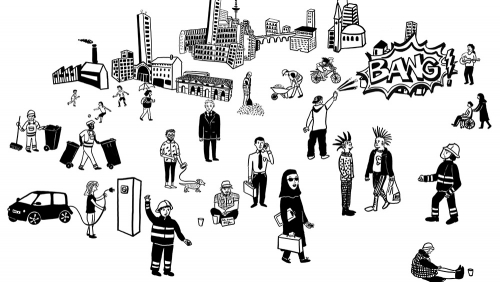
Notice: Undefined variable: skin in /homepages/21/d269329667/htdocs/clickandbuilds/Stadtkulturen/wp-content/plugins/media-element-html5-video-and-audio-player/mediaelement-js-wp.php on line 405
Notice: Undefined variable: src_attribute in /homepages/21/d269329667/htdocs/clickandbuilds/Stadtkulturen/wp-content/plugins/media-element-html5-video-and-audio-player/mediaelement-js-wp.php on line 410
Notice: Undefined variable: type_attribute in /homepages/21/d269329667/htdocs/clickandbuilds/Stadtkulturen/wp-content/plugins/media-element-html5-video-and-audio-player/mediaelement-js-wp.php on line 410
Notice: Undefined variable: poster_attribute in /homepages/21/d269329667/htdocs/clickandbuilds/Stadtkulturen/wp-content/plugins/media-element-html5-video-and-audio-player/mediaelement-js-wp.php on line 410
Notice: Undefined variable: autoplay_attribute in /homepages/21/d269329667/htdocs/clickandbuilds/Stadtkulturen/wp-content/plugins/media-element-html5-video-and-audio-player/mediaelement-js-wp.php on line 410
Notice: Undefined variable: mp3_source in /homepages/21/d269329667/htdocs/clickandbuilds/Stadtkulturen/wp-content/plugins/media-element-html5-video-and-audio-player/mediaelement-js-wp.php on line 412
Notice: Undefined variable: webm_source in /homepages/21/d269329667/htdocs/clickandbuilds/Stadtkulturen/wp-content/plugins/media-element-html5-video-and-audio-player/mediaelement-js-wp.php on line 413
Notice: Undefined variable: flv_source in /homepages/21/d269329667/htdocs/clickandbuilds/Stadtkulturen/wp-content/plugins/media-element-html5-video-and-audio-player/mediaelement-js-wp.php on line 414
Notice: Undefined variable: wmv_source in /homepages/21/d269329667/htdocs/clickandbuilds/Stadtkulturen/wp-content/plugins/media-element-html5-video-and-audio-player/mediaelement-js-wp.php on line 415
Notice: Undefined variable: ogg_source in /homepages/21/d269329667/htdocs/clickandbuilds/Stadtkulturen/wp-content/plugins/media-element-html5-video-and-audio-player/mediaelement-js-wp.php on line 416
Notice: Undefined variable: captions_source in /homepages/21/d269329667/htdocs/clickandbuilds/Stadtkulturen/wp-content/plugins/media-element-html5-video-and-audio-player/mediaelement-js-wp.php on line 417
Notice: Undefined variable: loop_option in /homepages/21/d269329667/htdocs/clickandbuilds/Stadtkulturen/wp-content/plugins/media-element-html5-video-and-audio-player/mediaelement-js-wp.php on line 423
Notice: Undefined variable: mediahtml in /homepages/21/d269329667/htdocs/clickandbuilds/Stadtkulturen/wp-content/plugins/media-element-html5-video-and-audio-player/mediaelement-js-wp.php on line 425
4:12
Urbanity as a social space
How the “poor doors” phenomenon stimulates research on today’s planning practices.
Video-collection on imaginary urbanity
What characterises imaginary urbanity? A collection of representations of urbanity – expanded by the website’s users.

Pinterest® is a digital service that has the potential to produce/contribute to producing urbanity in the sense of the imaginary of the city, since …

Notice: Undefined variable: skin in /homepages/21/d269329667/htdocs/clickandbuilds/Stadtkulturen/wp-content/plugins/media-element-html5-video-and-audio-player/mediaelement-js-wp.php on line 405
Notice: Undefined variable: src_attribute in /homepages/21/d269329667/htdocs/clickandbuilds/Stadtkulturen/wp-content/plugins/media-element-html5-video-and-audio-player/mediaelement-js-wp.php on line 410
Notice: Undefined variable: type_attribute in /homepages/21/d269329667/htdocs/clickandbuilds/Stadtkulturen/wp-content/plugins/media-element-html5-video-and-audio-player/mediaelement-js-wp.php on line 410
Notice: Undefined variable: width_attribute in /homepages/21/d269329667/htdocs/clickandbuilds/Stadtkulturen/wp-content/plugins/media-element-html5-video-and-audio-player/mediaelement-js-wp.php on line 410
Notice: Undefined variable: height_attribute in /homepages/21/d269329667/htdocs/clickandbuilds/Stadtkulturen/wp-content/plugins/media-element-html5-video-and-audio-player/mediaelement-js-wp.php on line 410
Notice: Undefined variable: poster_attribute in /homepages/21/d269329667/htdocs/clickandbuilds/Stadtkulturen/wp-content/plugins/media-element-html5-video-and-audio-player/mediaelement-js-wp.php on line 410
Notice: Undefined variable: autoplay_attribute in /homepages/21/d269329667/htdocs/clickandbuilds/Stadtkulturen/wp-content/plugins/media-element-html5-video-and-audio-player/mediaelement-js-wp.php on line 410
Notice: Undefined variable: mp4_source in /homepages/21/d269329667/htdocs/clickandbuilds/Stadtkulturen/wp-content/plugins/media-element-html5-video-and-audio-player/mediaelement-js-wp.php on line 411
Notice: Undefined variable: mp3_source in /homepages/21/d269329667/htdocs/clickandbuilds/Stadtkulturen/wp-content/plugins/media-element-html5-video-and-audio-player/mediaelement-js-wp.php on line 412
Notice: Undefined variable: webm_source in /homepages/21/d269329667/htdocs/clickandbuilds/Stadtkulturen/wp-content/plugins/media-element-html5-video-and-audio-player/mediaelement-js-wp.php on line 413
Notice: Undefined variable: flv_source in /homepages/21/d269329667/htdocs/clickandbuilds/Stadtkulturen/wp-content/plugins/media-element-html5-video-and-audio-player/mediaelement-js-wp.php on line 414
Notice: Undefined variable: wmv_source in /homepages/21/d269329667/htdocs/clickandbuilds/Stadtkulturen/wp-content/plugins/media-element-html5-video-and-audio-player/mediaelement-js-wp.php on line 415
Notice: Undefined variable: ogg_source in /homepages/21/d269329667/htdocs/clickandbuilds/Stadtkulturen/wp-content/plugins/media-element-html5-video-and-audio-player/mediaelement-js-wp.php on line 416
Notice: Undefined variable: captions_source in /homepages/21/d269329667/htdocs/clickandbuilds/Stadtkulturen/wp-content/plugins/media-element-html5-video-and-audio-player/mediaelement-js-wp.php on line 417
Notice: Undefined variable: loop_option in /homepages/21/d269329667/htdocs/clickandbuilds/Stadtkulturen/wp-content/plugins/media-element-html5-video-and-audio-player/mediaelement-js-wp.php on line 423
Notice: Undefined variable: mediahtml in /homepages/21/d269329667/htdocs/clickandbuilds/Stadtkulturen/wp-content/plugins/media-element-html5-video-and-audio-player/mediaelement-js-wp.php on line 425
1:44
Urbanity, assemblage and the footstep of a tram
Why did you choose the assemblage approach for your research? In conversation with Laura Kemmer about assemblage and her research on the Bonde tram in Rio de Janeiro.
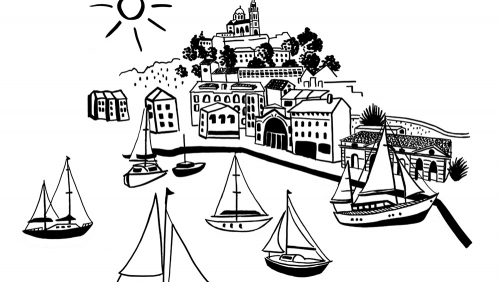
Notice: Undefined variable: skin in /homepages/21/d269329667/htdocs/clickandbuilds/Stadtkulturen/wp-content/plugins/media-element-html5-video-and-audio-player/mediaelement-js-wp.php on line 405
Notice: Undefined variable: src_attribute in /homepages/21/d269329667/htdocs/clickandbuilds/Stadtkulturen/wp-content/plugins/media-element-html5-video-and-audio-player/mediaelement-js-wp.php on line 410
Notice: Undefined variable: type_attribute in /homepages/21/d269329667/htdocs/clickandbuilds/Stadtkulturen/wp-content/plugins/media-element-html5-video-and-audio-player/mediaelement-js-wp.php on line 410
Notice: Undefined variable: poster_attribute in /homepages/21/d269329667/htdocs/clickandbuilds/Stadtkulturen/wp-content/plugins/media-element-html5-video-and-audio-player/mediaelement-js-wp.php on line 410
Notice: Undefined variable: autoplay_attribute in /homepages/21/d269329667/htdocs/clickandbuilds/Stadtkulturen/wp-content/plugins/media-element-html5-video-and-audio-player/mediaelement-js-wp.php on line 410
Notice: Undefined variable: mp3_source in /homepages/21/d269329667/htdocs/clickandbuilds/Stadtkulturen/wp-content/plugins/media-element-html5-video-and-audio-player/mediaelement-js-wp.php on line 412
Notice: Undefined variable: webm_source in /homepages/21/d269329667/htdocs/clickandbuilds/Stadtkulturen/wp-content/plugins/media-element-html5-video-and-audio-player/mediaelement-js-wp.php on line 413
Notice: Undefined variable: flv_source in /homepages/21/d269329667/htdocs/clickandbuilds/Stadtkulturen/wp-content/plugins/media-element-html5-video-and-audio-player/mediaelement-js-wp.php on line 414
Notice: Undefined variable: wmv_source in /homepages/21/d269329667/htdocs/clickandbuilds/Stadtkulturen/wp-content/plugins/media-element-html5-video-and-audio-player/mediaelement-js-wp.php on line 415
Notice: Undefined variable: ogg_source in /homepages/21/d269329667/htdocs/clickandbuilds/Stadtkulturen/wp-content/plugins/media-element-html5-video-and-audio-player/mediaelement-js-wp.php on line 416
Notice: Undefined variable: captions_source in /homepages/21/d269329667/htdocs/clickandbuilds/Stadtkulturen/wp-content/plugins/media-element-html5-video-and-audio-player/mediaelement-js-wp.php on line 417
Notice: Undefined variable: loop_option in /homepages/21/d269329667/htdocs/clickandbuilds/Stadtkulturen/wp-content/plugins/media-element-html5-video-and-audio-player/mediaelement-js-wp.php on line 423
Notice: Undefined variable: mediahtml in /homepages/21/d269329667/htdocs/clickandbuilds/Stadtkulturen/wp-content/plugins/media-element-html5-video-and-audio-player/mediaelement-js-wp.php on line 425
3:38
The imaginary of the city
How a hip-hop group influences thinking about Marseilles.
“Getty Images” – thinking in terms of the imaginary as a concept
Click through the webpage. To what extent does “Getty Images” produce urbanity in the sense of the imaginary?
Facebook® – thinking in terms of social space as a concept
Click through the page. How does Facebook® produce urbanity in the sense of the concept of social space?

Notice: Undefined variable: skin in /homepages/21/d269329667/htdocs/clickandbuilds/Stadtkulturen/wp-content/plugins/media-element-html5-video-and-audio-player/mediaelement-js-wp.php on line 405
Notice: Undefined variable: src_attribute in /homepages/21/d269329667/htdocs/clickandbuilds/Stadtkulturen/wp-content/plugins/media-element-html5-video-and-audio-player/mediaelement-js-wp.php on line 410
Notice: Undefined variable: type_attribute in /homepages/21/d269329667/htdocs/clickandbuilds/Stadtkulturen/wp-content/plugins/media-element-html5-video-and-audio-player/mediaelement-js-wp.php on line 410
Notice: Undefined variable: width_attribute in /homepages/21/d269329667/htdocs/clickandbuilds/Stadtkulturen/wp-content/plugins/media-element-html5-video-and-audio-player/mediaelement-js-wp.php on line 410
Notice: Undefined variable: height_attribute in /homepages/21/d269329667/htdocs/clickandbuilds/Stadtkulturen/wp-content/plugins/media-element-html5-video-and-audio-player/mediaelement-js-wp.php on line 410
Notice: Undefined variable: poster_attribute in /homepages/21/d269329667/htdocs/clickandbuilds/Stadtkulturen/wp-content/plugins/media-element-html5-video-and-audio-player/mediaelement-js-wp.php on line 410
Notice: Undefined variable: autoplay_attribute in /homepages/21/d269329667/htdocs/clickandbuilds/Stadtkulturen/wp-content/plugins/media-element-html5-video-and-audio-player/mediaelement-js-wp.php on line 410
Notice: Undefined variable: mp4_source in /homepages/21/d269329667/htdocs/clickandbuilds/Stadtkulturen/wp-content/plugins/media-element-html5-video-and-audio-player/mediaelement-js-wp.php on line 411
Notice: Undefined variable: mp3_source in /homepages/21/d269329667/htdocs/clickandbuilds/Stadtkulturen/wp-content/plugins/media-element-html5-video-and-audio-player/mediaelement-js-wp.php on line 412
Notice: Undefined variable: webm_source in /homepages/21/d269329667/htdocs/clickandbuilds/Stadtkulturen/wp-content/plugins/media-element-html5-video-and-audio-player/mediaelement-js-wp.php on line 413
Notice: Undefined variable: flv_source in /homepages/21/d269329667/htdocs/clickandbuilds/Stadtkulturen/wp-content/plugins/media-element-html5-video-and-audio-player/mediaelement-js-wp.php on line 414
Notice: Undefined variable: wmv_source in /homepages/21/d269329667/htdocs/clickandbuilds/Stadtkulturen/wp-content/plugins/media-element-html5-video-and-audio-player/mediaelement-js-wp.php on line 415
Notice: Undefined variable: ogg_source in /homepages/21/d269329667/htdocs/clickandbuilds/Stadtkulturen/wp-content/plugins/media-element-html5-video-and-audio-player/mediaelement-js-wp.php on line 416
Notice: Undefined variable: captions_source in /homepages/21/d269329667/htdocs/clickandbuilds/Stadtkulturen/wp-content/plugins/media-element-html5-video-and-audio-player/mediaelement-js-wp.php on line 417
Notice: Undefined variable: loop_option in /homepages/21/d269329667/htdocs/clickandbuilds/Stadtkulturen/wp-content/plugins/media-element-html5-video-and-audio-player/mediaelement-js-wp.php on line 423
Notice: Undefined variable: mediahtml in /homepages/21/d269329667/htdocs/clickandbuilds/Stadtkulturen/wp-content/plugins/media-element-html5-video-and-audio-player/mediaelement-js-wp.php on line 425
0:55
Assemblage and urban research
Why does the assemblage concept perspective especially suit urban research? In conversation with Laura Kemmer about assemblage and her research on the Bonde tram in Rio de Janeiro.
efoto® with the concept of imaginary thought
Click your way through the webpages. To what extent does efoto® produce urbanism in the sense of the imaginary?

Help
This website brings together very different materials such as bibliographies, wiki articles, explanatory films, interview extracts as sound documents, directly linked websites and much more. These materials invite you to get acquainted with urban cultural studies and the reflection of (one’s own) digital practices and the contribution they make to the production of urbanism. By clickin



A collection of sounds on the imaginary of urbanism
What characterises the imaginary of urbanity? A collection of representations of urbanity – expanded by the website’s users.

Tweeting is a digital practice that has the potential to produce/contribute to producing urbanity, since …

Notice: Undefined variable: skin in /homepages/21/d269329667/htdocs/clickandbuilds/Stadtkulturen/wp-content/plugins/media-element-html5-video-and-audio-player/mediaelement-js-wp.php on line 405
Notice: Undefined variable: src_attribute in /homepages/21/d269329667/htdocs/clickandbuilds/Stadtkulturen/wp-content/plugins/media-element-html5-video-and-audio-player/mediaelement-js-wp.php on line 410
Notice: Undefined variable: type_attribute in /homepages/21/d269329667/htdocs/clickandbuilds/Stadtkulturen/wp-content/plugins/media-element-html5-video-and-audio-player/mediaelement-js-wp.php on line 410
Notice: Undefined variable: width_attribute in /homepages/21/d269329667/htdocs/clickandbuilds/Stadtkulturen/wp-content/plugins/media-element-html5-video-and-audio-player/mediaelement-js-wp.php on line 410
Notice: Undefined variable: height_attribute in /homepages/21/d269329667/htdocs/clickandbuilds/Stadtkulturen/wp-content/plugins/media-element-html5-video-and-audio-player/mediaelement-js-wp.php on line 410
Notice: Undefined variable: poster_attribute in /homepages/21/d269329667/htdocs/clickandbuilds/Stadtkulturen/wp-content/plugins/media-element-html5-video-and-audio-player/mediaelement-js-wp.php on line 410
Notice: Undefined variable: autoplay_attribute in /homepages/21/d269329667/htdocs/clickandbuilds/Stadtkulturen/wp-content/plugins/media-element-html5-video-and-audio-player/mediaelement-js-wp.php on line 410
Notice: Undefined variable: mp4_source in /homepages/21/d269329667/htdocs/clickandbuilds/Stadtkulturen/wp-content/plugins/media-element-html5-video-and-audio-player/mediaelement-js-wp.php on line 411
Notice: Undefined variable: mp3_source in /homepages/21/d269329667/htdocs/clickandbuilds/Stadtkulturen/wp-content/plugins/media-element-html5-video-and-audio-player/mediaelement-js-wp.php on line 412
Notice: Undefined variable: webm_source in /homepages/21/d269329667/htdocs/clickandbuilds/Stadtkulturen/wp-content/plugins/media-element-html5-video-and-audio-player/mediaelement-js-wp.php on line 413
Notice: Undefined variable: flv_source in /homepages/21/d269329667/htdocs/clickandbuilds/Stadtkulturen/wp-content/plugins/media-element-html5-video-and-audio-player/mediaelement-js-wp.php on line 414
Notice: Undefined variable: wmv_source in /homepages/21/d269329667/htdocs/clickandbuilds/Stadtkulturen/wp-content/plugins/media-element-html5-video-and-audio-player/mediaelement-js-wp.php on line 415
Notice: Undefined variable: ogg_source in /homepages/21/d269329667/htdocs/clickandbuilds/Stadtkulturen/wp-content/plugins/media-element-html5-video-and-audio-player/mediaelement-js-wp.php on line 416
Notice: Undefined variable: captions_source in /homepages/21/d269329667/htdocs/clickandbuilds/Stadtkulturen/wp-content/plugins/media-element-html5-video-and-audio-player/mediaelement-js-wp.php on line 417
Notice: Undefined variable: loop_option in /homepages/21/d269329667/htdocs/clickandbuilds/Stadtkulturen/wp-content/plugins/media-element-html5-video-and-audio-player/mediaelement-js-wp.php on line 423
Notice: Undefined variable: mediahtml in /homepages/21/d269329667/htdocs/clickandbuilds/Stadtkulturen/wp-content/plugins/media-element-html5-video-and-audio-player/mediaelement-js-wp.php on line 425
2:16
Urbanism, social space and the internet
Have digitisation and the internet changed struggles for housing in New York and London? An excerpt from a conversation with Yuca Meubrink about her research on housing programs in New York City and London.

Bibliography: The concept of urbanism as social space
“I am primarily concerned with how capitalism creates a physical landscape of roads, houses, factories, schools, shops, and so forth in its own image and what the contradictions are that arise out of such a process of producing space.” (Harvey 1985: xv) BOURDIEU, PIERRE (1998): Ortseffekte. In: Kirchberg, Volker/ Göschel, Albrecht (Hg.): Kultur in der Stadt. Stadtsozi

Instagram® – thinking in terms of assemblage as a concept
Click through the webpage. To what extent does Instagram® produce urbanity in the sense of assemblage?

How is your perception of a city influenced by the internet, for example before going on a trip to a city? Pick a city and simulate the situation on the basis of the example city: what images do you encounter on websites for air or rail transport, for example? What information do you otherwise obtain when planning a trip? Reflect on the process which meets, expands and changes your expectations.
How fictional is urbanity? #theImaginary Who owns the city? #SocialSpace How urban is a city? #Assemblage Do cities have characters? #theImaginary What kind of borders do cities have? #SocialSpace Where does the city end? #Assemblage How do cities sound like? #theImaginary Are all urban citizens equal? #SocialSpace